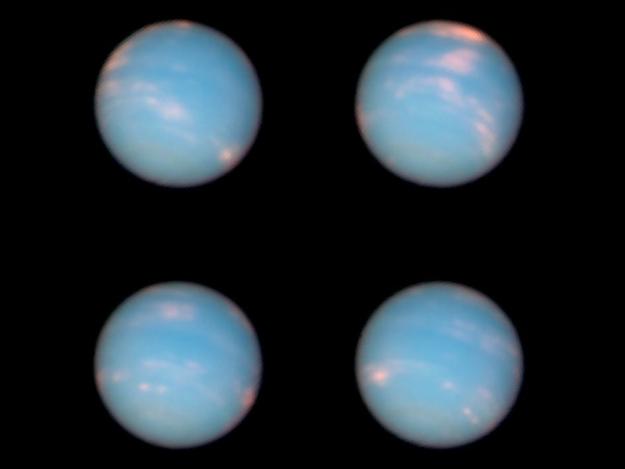
One-hundred-sixty-five years ago, Neptune, the eighth planet in our solar system, was discovered. Yesterday, Neptune returned to the spot it was discovered for the first time since. That’s 165 years to complete one single orbit around the Sun, and was certainly an occasion worthy of celebration. Thankfully, NASA had the Hubble Space Telescope pointed right at the blue orb to commemorate the anniversary.
Neptune is 2.8 billion miles from the Sun, or about 30 times farther than Earth. Being so far away not only means that Neptune’s orbit is slow, but also that the planet is freezing cold. The image above was taken at four hour intervals; with Neptune’s 16-hour day, those four shots cover the majority of the planet. The white fluffy streaks are indeed clouds, but not of the Earth variety. Instead, due to Neptune’s low ambient temperature, they’re actually high-altitude swaths of frozen methane.
According to NASA, Neptune has a 29-degree tilt, which, like Earth’s tilt of 23-degrees, causes the planet to experience seasons. Right now Neptune’s seasons are the opposite of Earth, with summer in the southern hemisphere and winter in the north. While here on Earth we switch between pants and shorts every few months, on Neptune each season lasts 40 years.

The image above is a composite of Hubble shots stitched together by NASA. The time lapse between shots explains why there appears to be multiple moons in the same orbits. NASA took numerous photos with three different color filters to bring out the true hue of Neptune’s atmosphere. More than 30 moons are known to orbit Neptune, but the majority orbit much too far away to have fit into this shot.
Editors' Recommendations
- See what the Hubble Space Telescope snapped on your birthday
- Revamped photo of ‘Pale Blue Dot’ reminds us how small we are
- This week’s Hubble image illustrates an ancient Egyptian myth
- Ten years in space: Remembering a decade of achievements in the final frontier
- Hubble investigates new type of super-puff planet with texture of cotton candy


